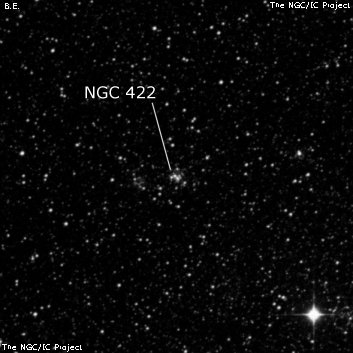
John Herschel discovered NGC 422 in 1836 with his 20-foot (18") reflector and it was included as #162 in his catalogue of "Stars, Nebulae, and Clusters in the Nubecula Minor". His position was 30 seconds of RA west (very small offset at this declination) of ESO 051-SC022 = Kron 65 = Lindsay 87, the faint cluster taken as NGC 422 by all modern sources (ESO, NED, SIMBAD, etc).
But Harold Corwin found that the entry #162 in "Stars, Nebulae, and Clusters in the Nubecula Minor" actually derives from Herschel's second observation of NGC 411 = h2384 ("eF; pL; R; glbM 2'.") on sweep 745 (5 Nov 1836) though he accidentally increased the RA by 1.0 tmin. So, NGC 411 has two entries in this table (both indicated as deriving from a sweep with his 18") -- #162, which is 1.0 tmin too large, and #157, which was copied correctly. Entry #162 later acquired the numbers GC 231 and NGC 422. So, NGC 422 = NGC 411 with NGC 411 the primary designation.
The cluster previously assumed to be NGC 422 was later discovered by DeLisle Stewart on plates taken in 1900 at Harvard's station in Arequipa, Peru and received the designation IC 1641. Instead, IC 1641 has been misidentified as a very faint cluster (Hodge-Wright 62) just following the real IC 1641. See Corwin's notes for more.
400/500mm - 18" (7/11/05 - Magellan Observatory, Australia): very faint, small, 30" diameter, low surface brightness and no hint of resolution. Follows NGC 411 by 7' and forms the eastern vertex of an equilateral triangle with NGC 411 and a mag 8 star 6' SW. Observation made through thin haze.
18" (7/6/02 - Magellan Observatory, Australia): this faint SMC cluster is located 7' following NGC 411. At 228x it appeared as just a very faint knot, less than 1' diameter with a low surface brightness and no resolution. Located 5.5' NE of mag 8.6 HD 7031.
Notes by Steve Gottlieb